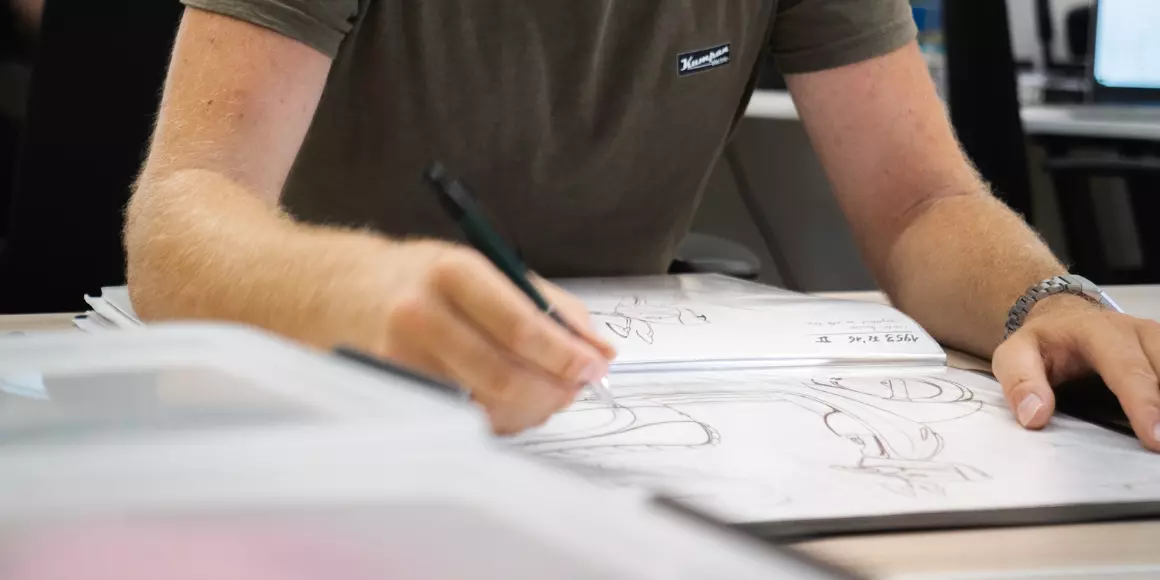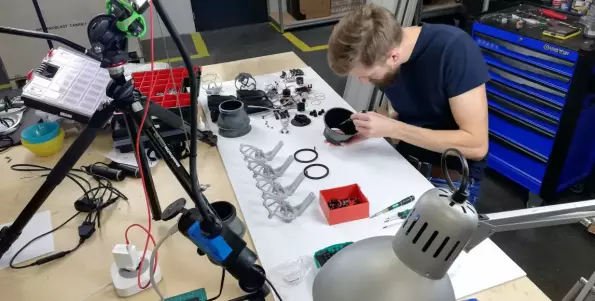- Mindsailors
- Blog
- industrialdesign
- How to Integrate Design for Manufacturing Into Your Designs

Have you ever been in a meeting with your engineering team and heard someone say something along the lines of "that's not possible" or "we can't do that"? If you have, then you are aware that it might be difficult to include DFM, which stands for "design for production," into the designs you create. However, you shouldn't be afraid since you can assist your team to avoid these frequent design barriers with a little bit of ingenuity and some advice from the experts. Stay tuned for our best recommendations on how to include DFM into your next design, and be sure to keep an eye out for them!
The term "Design for Manufacturing" abbreviated as "DFM," refers to a process that assists product designers in developing goods that are simple to produce. You can reduce the amount of time and money spent on production by implementing DFM principles into your designs early on in the process. In the following blog article, we will break down why DFM is such a vital part of the design process into a series of straightforward steps.

WHAT EXACTLY IS DFM, AND WHY IS IT SO ESSENTIAL?
The process of designing items with their capacity to be manufactured in mind is referred to as "design for manufacturing," or "DFM," in the manufacturing industry. DFM is used to help optimize a product so that it is simpler to manufacture, which can result in time and cost savings during the manufacturing process. There are several primary reasons why DFM plays such a significant role in product design, including the following:
- Ease of Manufacturing - There are a variety of reasons why the ease of manufacturing can quicken output and lower the expenses of production. To begin, creating anything with the ability to be manufactured in mind helps to optimize the manufacturing process, which in turn makes it more efficient. This enables the production of goods to occur at a faster rate and with a reduced number of faults. In addition, developing items with manufacturability in mind typically results in the assembly process requiring fewer stages, which in turn results in lower labor costs. Additionally, when things are simpler to create, there is less waste produced during the production process, which results in cheaper expenses associated with the manufacturing process. In conclusion, developing a product with manufacturability in mind can result in significant time and financial savings throughout production, making it an essential factor to take into account during the design phase of any product.
- Ensure that the Product Is Easy to Construct - If a product is difficult to assemble, this might cause the production process to be longer and more expensive. This is due to the fact that putting the product together can take more time than expected, and accidents sometimes happen, which can result in the product having to be taken apart and put back together again. This can be quite frustrating for the workers, and it can also create production delays. In addition, if a product is difficult to put together, there is a greater possibility that it may malfunction or break while it is being used. This may also result in higher expenditures for any repairs or replacements that are required.
- Design for Test - One of the primary advantages of designing for test is that it can assist in accelerating the process of testing. Be sure to pre-certify your products. You'll be able to diagnose issues more quickly and cut down on the number of product flaws if you make the product simpler to put through its paces. This may assist in shortening the amount of time required to bring the product to the market. In addition to this, creating a product with testing in mind can also help to improve its overall quality. Detecting errors at an early stage allows you to steer clear of time-consuming and expensive rework later on in the development process.
- Decreased Expenditures on Engineering – There are a few specific ways that decreasing expenditures on engineering can improve production. These include lowering the amount of time required to develop a product, lowering the amount of prototypes that are required, and lowering the amount of mistakes that are made during production.
By utilizing the concepts of "design for manufacturability," for instance, Ford Motor Company was able to cut the amount of time it needed to build a new automobile by approximately 30 percent. This resulted in cost savings for the company that were measured in the millions of dollars.
Another good example is the company Medtronic, which makes medical equipment. By adhering to the principles of design for manufacturability, they were able to cut the number of prototypes required for a new product by approximately fifty percent. Not only did this save them time and money, but it also made it possible for them to get their products to market in a more expedient manner.
In conclusion, applying the principles of design for manufacturability during the production process can help reduce the amount of errors that occur. By utilizing these concepts, for instance, Boeing was able to cut the number of flaws in their airplanes by a quarter of the total number. This resulted in an increase in safety in addition to quality improvements and decreased expenses associated with rework.

IDENTIFY FREQUENT DIFFICULTIES WITH PRODUCT DESIGNS AND HOW TO AVOID THEM
When it comes to coming up with items that are not only practical but also pleasing to the sight, product designers frequently find themselves up against a formidable obstacle. In many instances, these goods are faulty in one way or another, which may be the result of poor ergonomics, unstable construction, or instructions that are not accurate. To steer clear of these issues, product designers need to make it a point through carefully evaluating every facet of their creations, from the product's intended application to the manufacturing procedure. Designers may help ensure that their goods satisfy the requirements of both consumers and manufacturers if they take the time to produce designs that are comprehensive and well-rounded.
The lack of proper ergonomics in product design is one of the most frequently encountered issues. This happens when a product is designed without taking into account the person who will be using it. As a result, using the product may be awkward or even hazardous. In order to circumvent this issue, product designers need to pay careful attention to the manner in which customers will engage with their creation. They should also make certain that all of the components are within easy reach and that they can be used appropriately.
Another issue that frequently arises with product design is a build that is unstable. This can happen when a product is poorly constructed, and as a result, it has a risk of breaking apart or becoming hazardous while it is being used. In order to avoid this issue, the product's designers need to make certain that all of its components can be attached to one another in a safe and reliable manner.
Last but not least, giving inaccurate assembly instructions is one of the most significant issues with product design. This might happen if the instructions are not clear or difficult to follow, which can lead to annoyance for the customer as well as the possibility that the goods will be damaged. In order to prevent this problem, the designers need to make certain that the assembly instructions they provide are unambiguous and simple to understand. They should also conduct comprehensive testing on their prototypes to guarantee that they are secure and free from danger.

IN WHAT WAYS CAN YOU MAKE YOUR DESIGNS MORE DFM-FRIENDLY?
Including DFM in your designs can be accomplished by a few straightforward procedures, which are as follows:
- Conduct an Evaluation of Your Design The first thing you need to do is conduct an evaluation of your design and locate places in which DFM might be utilized. Look for ways to simplify the design, improve the way it can be assembled, or make it less difficult to test the product. If you’re unable to get a fresh perspective within your team, use a product development consultancy.
- Make Use of Standard Components Whenever it Is Possible, Use standard components because they are simple to get and have minimal manufacturing costs. This will make it much simpler to manufacture a large quantity of your product.
- Optimize the Geometry of Your Product You should make an effort to reduce the geometry of your product whenever it is practicable to do so. The manufacturing and assembly processes will be simplified as a result of this change.
- Make Use of Standard Procedures - When it is practical to do so, you should make use of standard processes, which are easy to comprehend and have minimal manufacturing costs. During the production process, the expenses will be reduced thanks to this.
- Collaborate with Manufacturers — Collaborate with manufacturers at an early stage in the design phase to receive their advice on challenges relating to manufacturability and potential cost-saving techniques.
You could be wondering to yourself if it is necessary to incorporate DFM in the early stages of concept creation. At the very least, you should discuss this matter with the other members of your team. The majority of the time, design teams make the error of waiting until they are in the middle of the design process before thinking about the product's capacity to be manufactured. By this point, it is typically too late to make meaningful modifications to the design.
SEVERAL PRODUCT DESIGN EXAMPLES DEMONSTRATING THE APPLICATION OF DFM
The term "Design for Manufacturing," abbreviated as "DFM," refers to a process that assists product designers in developing goods that are simple to produce. You can reduce the amount of time and money spent on production by implementing DFM principles into your designs early on in the process. The following are some illustrations of how DFM has been implemented in product design:
- The iPhone 6 was created with the design for manufacturing (DFM) concepts in mind. Apple was able to develop a phone that was simple to construct by including features such as rounded edges and accurate measurements in the blueprints for the device. During the production process, this resulted in cost and time savings for the company.
- The GoPro HERO4 camera was likewise developed keeping DFM principles in mind during the design process. The camera's designers made it simple to construct and test by incorporating characteristics such as a flat bottom and a straightforward attachment method into the device. This contributed to a reduction in manufacturing costs while simultaneously improving product quality.
- When developing the new G502 Proteus Core gaming mouse, the team at Logitech kept the DFM principles in mind throughout the entire process. They simplified the process of manufacturing the mouse by including elements such as a cable system that was modular and a chassis that was simple to open. This assisted in lowering overall expenses while also helping to increase overall product quality.
A FEW CLOSING WORDS ON THE CRUCIAL ROLE THAT DFM PLAYS IN THE DESIGN PROCESS
The term "Design for Manufacturing," abbreviated as "DFM," refers to a process that assists product designers in developing goods that are simple to produce. You can reduce the amount of time and money spent on production by implementing DFM principles into your designs early on in the process.
The design for manufacturing (DFM) step of the design process is an important one since it helps ensure that the final product can be manufactured in an effective and economical manner. You can save money and avoid time-consuming and frustrating rework and delays in the production process if you design for manufacturability.
You have a number of options at your disposal to enhance the design of your product in a way that makes it more amenable to manufacturing. The following are some essential DFM tips:
- Attempt to make the design as straightforward as you can. Reduce as much as possible the amount of components and processes involved in the assembly.
- Make use of standardized building materials and production methods whenever it is feasible to do so.
- Ensure that all of the dimensions are correct, and that the tolerances are reasonable.
- Steer clear of intricate geometries and strict tolerances, both of which are difficult to build.
- To simplify the process of putting the parts together, use symmetry and repetition.
- Make sure to label all of the components and, whenever it's possible, use standard connector types.
- When it is possible, position the fasteners on the outside of the object; this will make it much simpler to access and remove them during the assembly process.
- Steer clear of members that are excessively long and thin because they are more likely to bend and break.
- Collaborate with manufacturers early on in the design phase to solicit their feedback on concerns related to the product's ability to be manufactured.
You'll be able to increase the productivity of your manufacturing process and produce a product of higher quality all around if you follow these DFM best practices.
As can be seen, the Design for Manufacturing phase of the design process is an extremely important one. You may save both time and money during production if you start thinking about DFM early on in the process. If you are currently working on the design of a new product, make sure that you keep DFM in mind!
You are welcome to post a comment below or get in touch with us directly if you have any queries on how to apply DFM principles to the designs you create. When it comes to meeting your requirements for product development, we are always delighted to lend a hand.
Contact us with details under THIS LINK or contact us directly by phone or e-mail HERE.
How to Integrate Design for Manufacturing Into Your Designs
Schedule an initial talk and get to know us better! You already have a basic brief? Send it over so we can have a more productive first meeting!
a meeting





